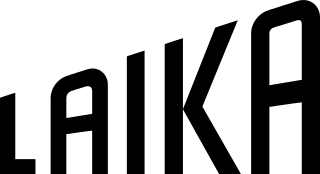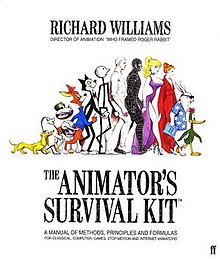
Animation is a filmmaking technique by which still images are manipulated to create moving images. In traditional animation, images are drawn or painted by hand on transparent celluloid sheets (cels) to be photographed and exhibited on film. Animation has been recognized as an artistic medium, specifically within the entertainment industry. Many animations are computer animations made with computer-generated imagery (CGI). Stop motion animation, in particular claymation, has continued to exist alongside these other forms.

Computer animation is the process used for digitally generating moving images. The more general term computer-generated imagery (CGI) encompasses both still images and moving images, while computer animation only refers to moving images. Modern computer animation usually uses 3D computer graphics.

Stop motion is an animated filmmaking technique in which objects are physically manipulated in small increments between individually photographed frames so that they will appear to exhibit independent motion or change when the series of frames is played back. Any kind of object can thus be animated, but puppets with movable joints or plasticine figures are most commonly used. Puppets, models or clay figures built around an armature are used in model animation. Stop motion with live actors is often referred to as pixilation. Stop motion of flat materials such as paper, fabrics or photographs is usually called cutout animation.
Inbetweening, also known as tweening, is a process in animation that involves creating intermediate frames, called inbetweens, between two keyframes. The intended result is to create the illusion of movement by smoothly transitioning one image into another.

Richard Edmund Williams was a Canadian-British animator, voice actor, and painter. A three-time Academy Award winner, he is best known as the animation director on Who Framed Roger Rabbit (1988) -- for which he won two Academy Awards -- and as the director of his unfinished feature film The Thief and the Cobbler (1993). His work on the short film A Christmas Carol (1971) earned him his first Academy Award. He was also a film title sequence designer and animator. Other works in this field include the title sequences for What's New Pussycat? (1965) and A Funny Thing Happened on the Way to the Forum (1966), title and linking sequences in The Charge of the Light Brigade, and the intros of the eponymous cartoon feline for two of the later Pink Panther films. In 2002 he published The Animator's Survival Kit, an authoritative manual of animation methods and techniques, which has since been turned into a 16-DVD box set as well as an iOS app. From 2008 he worked as artist in residence at Aardman Animations in Bristol, and in 2015 he received both Oscar and BAFTA nominations in the best animated short category for his short film Prologue.

Claymation, sometimes called clay animation or plasticine animation, is one of many forms of stop-motion animation. Each animated piece, either character or background, is "deformable"—made of a malleable substance, usually plasticine clay.

Traditional animation is an animation technique in which each frame is drawn by hand. The technique was the dominant form of animation, until the final few years of the 20th century, when there was a shift to computer animation in the industry, specifically 3D computer animation.

Cutout animation is a form of stop-motion animation using flat characters, props and backgrounds cut from materials such as paper, card, stiff fabric or photographs. The props would be cut out and used as puppets for stop motion. The world's earliest known animated feature films were cutout animations, as is the world's earliest surviving animated feature Die Abenteuer des Prinzen Achmed (1926) by Lotte Reiniger.

Disney Animation: The Illusion of Life is a book by Frank Thomas and Ollie Johnston, two of the key animators at Disney during the Golden age of American animation.
Character animation is a specialized area of the animation process, which involves bringing animated characters to life. The role of a character animator is analogous to that of a film or stage actor and character animators are often said to be "actors with a pencil". Character animators breathe life in their characters, creating the illusion of thought, emotion and personality. Character animation is often distinguished from creature animation, which involves bringing photorealistic animals and creatures to life.

Motion graphic design, also known as motion design, is a subset of graphic design which combines design with animation and/or filmmaking, video production, and filmic techniques. Examples include kinetic typography and graphics used in film and television opening sequences, and station identification logos of some television channels.

Laika, LLC is an American production company specializing in stop-motion animation and forthcoming live-action feature films, commercial content for all media, music videos, and short films. The studio is best known for its stop-motion feature films Coraline, ParaNorman, The Boxtrolls, Kubo and the Two Strings and Missing Link. It is owned by Nike co-founder Phil Knight and is located in Hillsboro, Oregon, part of the Portland metropolitan area. Knight's son, Travis Knight, acts as Laika's president and CEO.

Motion graphics are pieces of animation or digital footage that create the illusion of motion or rotation, and are usually combined with audio for use in multimedia projects. Motion graphics are usually displayed via electronic media technology, but may also be displayed via manual powered technology. The term distinguishes static graphics from those with a transforming appearance over time, without over-specifying the form. While any form of experimental or abstract animation can be called motion graphics, the term typically more explicitly refers to the commercial application of animation and effects to video, film, TV, and interactive applications.

Disney's twelve basic principles of animation were introduced by the Disney animators Ollie Johnston and Frank Thomas in their 1981 book The Illusion of Life: Disney Animation.[a] The principles are based on the work of Disney animators from the 1930s onwards, in their quest to produce more realistic animation. The main purpose of these principles was to produce an illusion that cartoon characters adhered to the basic laws of physics, but they also dealt with more abstract issues, such as emotional timing and character appeal.

Olivier Cotte is a French writer, graphic novel scriptwriter, animation historian, illustrator, and a director.
BLA BLA is an interactive animated film for computer created by Vincent Morisset with Montreal studio AATOAA, and produced by the National Film Board of Canada. The online work has been described as exploring "the principles of human communication," and follows Morisset's collaborations with Arcade Fire on Neon Bible, considered the first interactive music video.

Anticipation is one of the fundamental 12 basic principles of animation, as set out by Frank Thomas and Ollie Johnston in their authoritative 1981 book on the Disney Studio titled The Illusion of Life. An anticipation pose or drawing is a preparation for the main action of an animated scene, as distinct from the action and the reaction.
Straight ahead is a term used in animation that refers to a method that uses only the first key pose of a character, and then continues drawing the character to create the desired motion. It was first referred to in the 1981 book by Ollie Johnson and Frank Thomas The Illusion of Life, and is a part of the 12 Basic Principles of Animation. It contrasts with its converse, pose to pose animation, in that it does not use inbetweening. Straight ahead action is so named because the animator literally works straight ahead from the first drawing of the scene. Disney director-animator Woolie Reitherman said, "When I didn't know what I was doing in an action, I always went straight-ahead. I'd just start on ones. Half the time I didn't know what I was doing. To me, it's fun. You find out something you wouldn't have found out otherwise."
In animation, a smear frame is a frame used to simulate motion blur. Smear frames are used in between key frames. This animation technique has been used since the 1940s. Smear frames are used to stylistically visualize fast movement along a path of motion.













